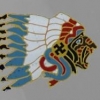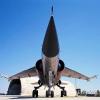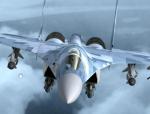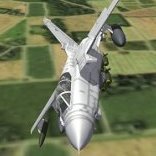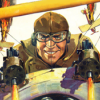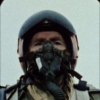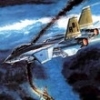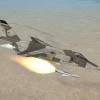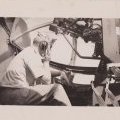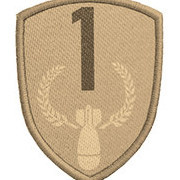Leaderboard
Popular Content
Showing most liked content on 09/05/2017 in all areas
-
7 pointsWIP Camo... from the MiG-29K templates. This camo needs several adjusments!
-
6 points
-
5 points
-
4 pointsThe hours of work that went into KAW over the years will never be replicated by commercial sim. Freeware has its limitations. It can be slow. The quality is inconsistent. The community becomes fragmented over time. If the work isn't accomplished fast enough, the project often dissolves before making any real progress. The original SFP1 version that worked with Service Pack 2a was quite good. But all of the additional years poured into the development of the current SF2 release is quite noticeable and an amazing achievement. Thanks to everyone that was involved :)
-
3 points
-
3 points
-
2 pointsI started with original Tornado F3, but finally not so much left from this model ;-) Step by step I've rewoked almost everything .
-
2 points
-
2 points
-
2 points582nd IAP Combat Maneuvers. 'Tho' much is taken, much abides; and though We are not now that strength which in old days Moved earth and heaven; that which we are, we are; One equal temper of heroic hearts, Made weak by time and fate, but strong in will To strive, to seek, to find, and not to yield.' Rostock High Speed Pass. Phantoms Feint of the Cobra And I Missed...
-
1 pointI'm very happy to present the new CAF team plane, the MiG-19SK. The CAF team is formed by Cocas, Wrench, Coupi, Nyghtfall, Valastur and Stratos. The MiG-19SK has been a truly team effort to deliver a fun, challenging and realistic plane for a early carrier based soviet navy squadrons. It all started thanks to Dizzyfugu, a WhatIf master, with this entry. https://www.flickr.com/photos/dizzyfugu/page22 Then everything started to move forward in the CAF team. We asked permission to Dizzyfugu to release the plane, and he kindly agreed, so kudos to him! Thanks mate! So without more waiting, the MiG-19SK story... After the success of the Soviet Union’s first carrier ship, the Moskva Class (Projekt 1123, also called „Кондор“/„Kondor“) cruisers in the mid 1960s, the country became more ambitious. This resulted in Project 1153 Orel (Russian: Орёл, Eagle), a planned 1970s-era Soviet program to give the Soviet Navy a true blue water aviation capability. Project Orel would have resulted in a program very similar to the aircraft carriers available to the U.S. Navy. The ship would have been about 75-80,000 tons displacement, with a nuclear power plant and carried about 70 aircraft launched via steam catapults – the first Soviet aircraft carrier that would be able to deploy fixed-wing aircraft. Beyond this core capability, the Orel carrier was designed with a large offensive capability with the ship mounts including 24 vertical launch tubes for anti-ship cruise missiles. In the USSR it was actually classified as the "large cruiser with aircraft armament". Anyway, the carrier needed appropriate aircraft, and in order to develop a the aircraft major design bureaus were asked to submit ideas and proposals in 1959. OKB Yakovlev and MiG responded. While Yakovlev concentrated on the Yak-36 VTOL design that could also be deployed aboard of smaller ships without catapult and arrester equipment, Mikoyan-Gurevich looked at navalized variants of existing or projected aircraft. While land-based fighters went through a remarkable performance improvement during the 60ies, OKB MiG considered a robust aircraft with proven systems and – foremost – two engines to be the best start for the Soviet Union’s first naval fighter. “Learning by doing”, the gathered experience would then be used in a dedicated new design that would be ready in the mid 70ies when Project 1153 was ready for service, too. Internally designated “I-SK” or “SK-01” (Samolyot Korabelniy = carrier-borne aircraft), the naval fighter was based on the MiG-19 (NATO: Farmer), which had been in production in the USSR since 1954. Faster and more modern types like the MiG-21 were rejected for a naval conversion because of their poor take-off performance, uncertain aerodynamics in the naval environment and lack of ruggedness. The MiG-19 also offered the benefit of relatively compact dimensions, as well as a structure that would carry the desired two engines. Several innovations had to be addresses: - A new wing for improved low speed handling - Improvement of the landing gear and internal structures for carrier operations - Development of a wing folding mechanism - Integration of arrester hook and catapult launch devices into the structure - Protection of structure, engine and equipment from the aggressive naval environment - Improvement of the pilot’s field of view for carrier landings - Improved avionics, esp. for navigation Work on the SK-01 started in 1960, and by 1962 a heavily redesigned MiG-19 was ready as a mock-up for inspection and further approval. The “new” aircraft shared the outlines with the land-based MiG-19, but the nose section was completely new and shared a certain similarity to the experimental “Aircraft SN”, a MiG-17 derivative with side air intakes and a solid nose that carried a. Unlike the latter, the cockpit had been moved forward, which offered, together with an enlarged canopy and a short nose, an excellent field of view for the pilot. On the SK-01 the air intakes with short splitter plates were re-located to the fuselage flanks underneath the cockpit. In order to avoid gun smoke ingestion problems (and the lack of space in the nose for any equipment except for a small SRD-3 Grad gun ranging radar, coupled with an ASP-5N computing gun-sight), the SK-01’s internal armament, a pair of NR-30 cannon, was placed in the wing roots. The wing itself was another major modification, it featured a reduced sweep of only 33° at ¼ chord angle (compared to the MiG-19’s original 55°). Four wing hardpoints, outside of the landing gear wells, could carry a modest ordnance payload, including rocket and gun pods, unguided missiles, iron bombs and up to four Vympel K-13 AAMs. Outside of these pylons, the wings featured a folding mechanism that allowed the wing span to be reduced from 10 m to 6.5 m for stowage. The fin remained unchanged, but the stabilizers had a reduced sweep, too. The single ventral fin of the MiG-19 gave way to a fairing for a massive, semi-retractable arrester hook, flanked by a pair of smaller fins. The landing gear was beefed up, too, with a stronger suspension. Catapult launch from deck was to be realized through expandable cables that were attached onto massive hooks under the fuselage. The SK-01 received a “thumbs up” in March 1962 and three prototypes, powered by special Sorokin R3M-28 engines, derivatives of the MiG-19's RB-9 that were adapted to the naval environment, were created and tested until 1964, when the type – now designated MiG-SK – went through State Acceptance Trials, including simulated landing tests on an “unsinkalble carrier” dummy, a modified part of the runway at Air Base at the Western coast of the Caspian Sea. Not only flight tests were conducted at Kaspiysk, but also different layouts for landing cables were tested and optimized as well. Furthermore, on a special platform at the coast, an experimental steam catapult went through trials, even though no aircraft starts were made from it – but weights hauled out into the sea. Anyway, the flight tests and the landing performance on the simulated carrier deck were successful, and while the MiG-SK (the machine differed from the MiG-19 so much that it was not recognized as an official MiG-19 variant) was not an outstanding combat aircraft, rather a technology carrier with field use capabilities. The MiG-SK’s performance was good enough to earn OKB MiG an initial production run of 20 aircraft, primarily intended for training and development units, since the whole infrastructure and procedures for naval aviation from a carrier had to be developed from scratch. These machines were built at slow pace until 1965 and trials were carried out in the vicinity of the Black Sea and the Caspian Sea. FROM NOW ON IS MY WORK. STRATOS. With the reception of the first new carrier in late 1965, the new aircraft began sea trials during the spring of 1966 and for summer the first planes were permanently deployed on board. The ship and it's planes began a cruise around the world doing good will port visits showing the flag and the new capabilities of the Soviet Navy. The carrier was permanently escorted by USN info gathering ships monitoring the capabilities of the new vessel and its air component. The first real deployment with combat ocured in the Pacific Ocean in 1969, in a dare move, the carrier slipped into the Yellow Sea during the night and launched it's aircraft at first light, the planes strike several military facilities in China mainland, specially around Shangai, and the first A-A combat took place when a pair of SK's engaged intercepting J-6 of the PLAAF while escorting strike armed SK's. All the soviets returned to the carrier that was already steaming to get out of the South China sea trough Tsushima straits. By early 1972, new models are being introduced into the fleet and the SK's started to show their age in the fast pace of aviation during Cold War, so as soon as the new models completed the air component the SK's were passed to train new naval pilots on the fleet training installations in Crimea, were it served with distinction until the last cells were too worn out to be safely operated beyond 1980. So the SK's story came to an end with the honor of being the first real combat aircraft onboard soviet carriers, and the plane that first tasted the blood for carrier based pilots. And some pictures of the plane itself. There will be several skins included in the release. The plane will be available for download pretty soon. Thanks.
-
This post cannot be displayed because it is in a password protected forum. Enter Password
-
1 pointThe Junkers J.1 is mapped and the baseline colors laid in. Pretty soon, I'll pass it on to Quack for him to finish.
-
1 pointI'm back :) perfect mod to install and try out first , it's been a while .
-
1 pointI'm agree with You streakeagle! I like KAW and plenty of others beautiful mods! If only TK could update SF2... technologies (GPU, CPU, Windows, etc) are being evolved from the last (ultimate?) 2013 patch!
-
1 point
-
1 point
-
1 point
-
1 point
-
1 pointWrenchs' idea of a roadside gas station/garage/hot dog stand/whatever seems to work quite well. The bus shows up on at least two tiles, maybe more. I think I will just go with this for the beta terrain and leave the tiles alone.
-
1 point
-
1 point
-
1 point
-
1 point
-
1 point
-
1 point23 August 1954, the YC-130A took off for the first time. This has started a production run still going 63 years later and a machine that will be in service 100 years past that first flight.
-
1 point
-
1 point
-
1 pointnot to thread hijack but while talking about missing members is veltro2k doing ok? i remember he was having some issues bout modding, bout still miss hearin from him even if he's done modding
-
1 point
-
1 pointHaving Fun, More Than One Way To Skin A Cat With Limited Resources, Scales Obviously Look Off But It Serves The Purpose. Two versions of the SSC-2 were developed from the Soviet "KENNEL" air-to-surface anti-shipping missile. They resemble a small jet fighter in appearance and are transported on one-axle semitrailers. The field missile SSC-2a "SALISH" is launched from its transport semitrailer which is towed by a KrAZ-214 tractor truck The SSC-2b "SAMLET" coastal missile transport semitrailer is towed by a ZIL-157V tractor truck and is not used for launching. The missile must be removed from the transport semitrailer and placed on a large rail-type launcher for firing. The "SAMLET" coastal defense missile is the most commonly encountered cruise missile, and has been identified in East Germany and Poland. Another Note of Interest From The Archives Of History. SSC-2a Salish was a nuclear capable mobile launching system designed for ground combat. With a 12 kiloton warhead and 180km range it entered the equipment of Soviet and DDR forces in 1957. It carried nuclear warheads with yields from 5 to 14 kilotons. Unknown to the US military during the Cuban missile crisis, two FKR regiments (the 561st and 584th) armed with 80 fourteen kiloton warheads were positioned in Cuba — one to attack the American base at Guantanamo with the second positioned near Havana to destroy any units attempting landings. Although some authorities dispute whether local commanders had authority to use these theater nuclear weapons, the weapons were present and it is argued that if pressured, Soviet soldiers might have used them.
-
1 pointa two fer today.... 23 July 1970: the first rollout of the DC-10 airliner at the McDonnell Douglas Plant in Long Beach. After testing was completed the first aircraft went on to fly for over twenty years with American Airlines, before being converted to MD-10 standard then serving another few years with FedEx before being scrapped in 2002 23 July 1983: due to issues with fuel calculations, Air Canada Flight 143 runs out of fuel over Ottawa and had to make an emergency engine out landing in a Boeing 767-100 at Gimli Motorsports Park (formerly RCAF Station Gimli). Due to both engines stopping, the aircraft lost all electrical and hydraulic power, and glided silently to a landing at the former airbase.
-
1 point
-
1 point
-
1 point
Version
23 downloads
A-10 Ferris Splinter [Fictional] This is a basic Splinter scheme based on an F-15C design modified for the A-10 airframe, and also some artistic liberties as well. While the A-10C is shown, this can also be used on the A-10A, simply copy and paste the folder into the Bazar\Liveries\A-10A or A-10C and select “Ferris Splinter No.1” in the Payload Menu and go fly. -
0 points5 May 2017 (yes, it is today). Recce Phantoms land for the last time in Europe. This day marks the retirement of the last RF-4E Phantoms of the Hellenic Air Force. "This jet will remain deeply rooted in our hearts. It not only represents 15 tonnes of metal, it is our most faithful friend, the one that offered us unforgettable moments, it’s a piece of our lives. The last Hellenic RF-4E Phantom II will land for the last time on May 5, 2017. Goodbye friend…" - Lt Col Dimitrios Papadimitriou, the last commander of 348 MTA.
Important Information
By using this site, you agree to our Terms of Use, Privacy Policy, and We have placed cookies on your device to help make this website better. You can adjust your cookie settings, otherwise we'll assume you're okay to continue..

